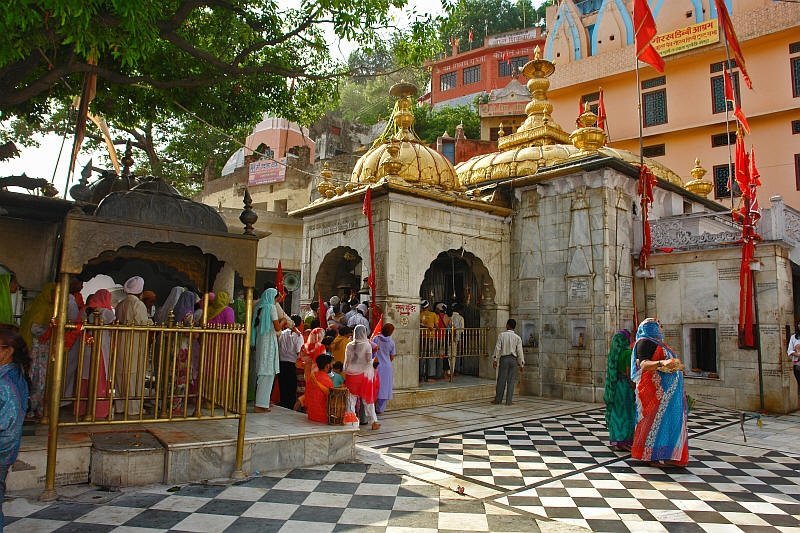 Jwala Ji The best known Jwala Ji shrine is located in the lower Himalayas in Jawalamukhi town of the Kangra district of Himachal Pradesh state of India, about 55 kilometers from the larger town of Dharamsala. The Jwala Ji temple style is typical of Jwala Ji shrines, four cornered, with a small dome on the top and a square central pit of hollowed stone inside where the main flame burns endlessly. An annual fair is held in the environs of the temple every July/August months during Navratras. The Jwala Ji temple had an associated library of ancient Hindu texts, many of which were translated from Sanskrit into Persian at the orders of Firuz Shah Tughlaq when the Delhi Sultanate overran the Kangra area. According to the legend, when Sati’s body was divided into 51 parts, Sati Mata’s tongue fell here. The flames/ Jyotis are the representation of the same. Some say that Sati’s clothes fell here. When they fell they were on fire. The fire hasn’t blew off. Jwala ji (flame) or Jwala Mukhi (flame mouth) is probably the most ancient temple discussed here besides Vaishno Devi. It is mentioned in the Mahabharata and other scriptures. There is a natural cave where eternal flames continue to burn. Some say there are seven or nine flames for the seven divine sisters or the nine Durgas. It is here that Sati’s tongue fell which can now be seen in the form of the flame.
Jwala Ji The best known Jwala Ji shrine is located in the lower Himalayas in Jawalamukhi town of the Kangra district of Himachal Pradesh state of India, about 55 kilometers from the larger town of Dharamsala. The Jwala Ji temple style is typical of Jwala Ji shrines, four cornered, with a small dome on the top and a square central pit of hollowed stone inside where the main flame burns endlessly. An annual fair is held in the environs of the temple every July/August months during Navratras. The Jwala Ji temple had an associated library of ancient Hindu texts, many of which were translated from Sanskrit into Persian at the orders of Firuz Shah Tughlaq when the Delhi Sultanate overran the Kangra area. According to the legend, when Sati’s body was divided into 51 parts, Sati Mata’s tongue fell here. The flames/ Jyotis are the representation of the same. Some say that Sati’s clothes fell here. When they fell they were on fire. The fire hasn’t blew off. Jwala ji (flame) or Jwala Mukhi (flame mouth) is probably the most ancient temple discussed here besides Vaishno Devi. It is mentioned in the Mahabharata and other scriptures. There is a natural cave where eternal flames continue to burn. Some say there are seven or nine flames for the seven divine sisters or the nine Durgas. It is here that Sati’s tongue fell which can now be seen in the form of the flame.
The Legend Jwala Ji
A cowherd found that one of his cows was always without milk. He followed the cow to find out the cause. He saw a girl come out of the forest, drink the cows milk, and then disappear in a flash of light. The cowherd went to the king and told him the story. The king was aware of the legend that Sati’s tongue had fallen in this area. The king tried, without success, to find that sacred spot.
Again, some years later, the cowherd went to the king to report that he had seen a flame burning in the mountains. The king found the spot and had darshan (vision) of the holy flame. He built a temple there and arranged for priests to enguage in regular worship.
It is believed that the Pandavas came later and renovated the temple.
It was Dhyanu Bhagat who spread Devi Mata’s name. He lived at the time of the Mughal Emperor Akbar. Dhyanu Bhagat was passing through Delhi with a group of pilgrims on their way to Jwalaji. Akbar summoned him to his court to inquire into the nature of their Goddess. Dhyanu Bhagat told him She is all powerful and answers the prayers of Her devotees.
To test Her power Akbar cut off the head of Dhyanu’s horse ordering him to have the Goddess put it back. Dhyanu went to Jwala Ji and prayed day and night to no avail. Out of desperation he cut of his own head and offered it to Devi Ma. She then appeared to him riding a lion. She reconnected both his head and that of the horse. Devi Ma also offered Dhyanu Bhagat a boon. He requested that it should not be so difficult for pigrams to show their devotion. Mata said that in the future if someone offered a coconut she
would accept it as if they had offered their own head. To this day people continue to offer coconuts to the Goddess in Her temples all over the world. Jwala mata is Kuldevi of Bhatiya (now lives in Gujarat) and Bhardwaj Gutra Brahmins.



